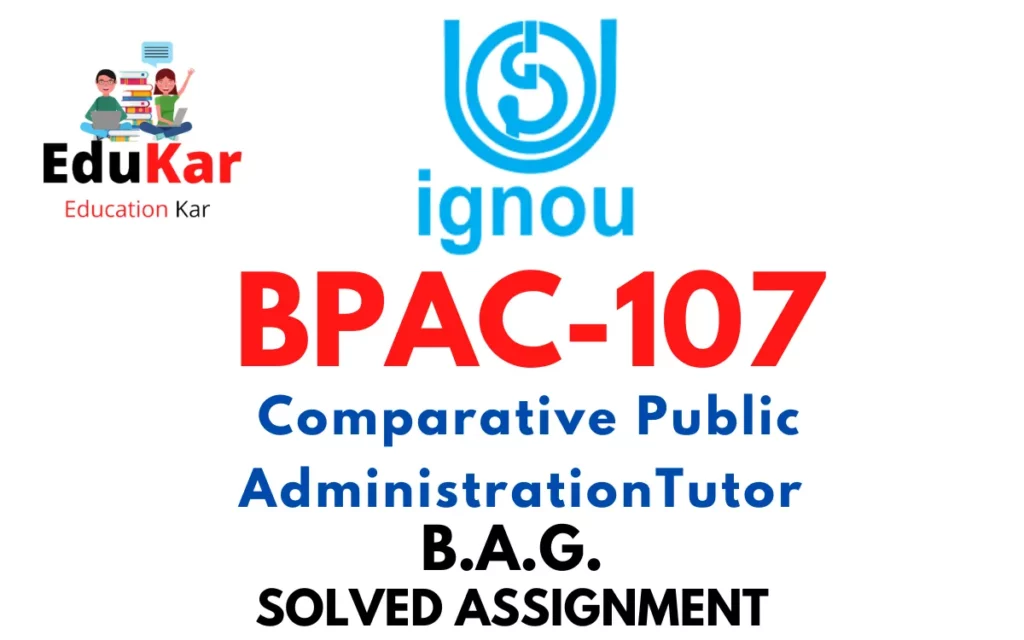Contents
- 1 Assignment A
- 2 Answer the following questions in about 500 words each.
- 3 1. Highlight the major challenges of globalisation.
- 4 2. Discuss various types and theories of social capital.
- 5 Assignment B
- 6 Answer the following questions in about 250 words each.
- 7 3. Describe the various approaches to corporate social responsibility.
- 8 4. Discuss the features of digital governance.
- 9 5. Examine the need for administrative ethics.
- 10 Assignment C
- 11 Answer the following questions in about100 words each.
- 12 6. What is a public private partnership?
- 13 7. Define decentralisaiton.
- 14 8. What do you mean by citizen’s charter?
- 15 9. Write a short note on major dimensions of social exclusion.
- 16 10. Describe the means of conflict resolution.

| Title | BPAC-114: IGNOU BAG Solved Assignment 2022-2023 |
| University | IGNOU |
| Degree | Bachelor Degree Programme |
| Course Code | BPAC-114 |
| Course Name | CONTEMPORARY ISSUES AND CONCERNS IN INDIAN ADMINISTRATION |
| Programme Name | Bachelor of Arts (General) |
| Programme Code | BAG |
| Total Marks | 100 |
| Year | 2022-2023 |
| Language | English |
| Assignment Code | ASST /TMA / July 2022 & January 2023 |
| Assignment PDF | Click Here |
| Last Date for Submission of Assignment: | For June Examination: 31st April For December Examination: 30th September |

Assignment A
Answer the following questions in about 500 words each.
1. Highlight the major challenges of globalisation.
Ans: Globalization, which refers to the process of increased interdependence and integration of economies, societies, and cultures across the world, has brought about many opportunities and benefits. However, it has also posed several challenges that affect people, communities, and countries in various ways. In this essay, I will highlight the major challenges of globalization.
- Unequal distribution of benefits: One of the main challenges of globalization is that it has not benefited all countries and people equally. While some countries have experienced significant economic growth and development, others have remained poor and marginalized. The benefits of globalization are often concentrated in developed countries and among the wealthy, leaving many developing countries and poor people behind. This unequal distribution of benefits has led to a widening income gap between the rich and poor, both within and between countries.
- Job displacement and inequality: Globalization has also resulted in the displacement of jobs, particularly in the manufacturing and service sectors. As companies move their operations to countries with lower labor costs, many workers in developed countries have lost their jobs. This has led to increased inequality and job insecurity. In addition, the jobs that are created in developing countries often pay low wages and have poor working conditions, leading to exploitation and human rights violations.
- Environmental degradation: The globalized economy has resulted in increased consumption and production, leading to environmental degradation and climate change. The overuse of natural resources, pollution, and greenhouse gas emissions are some of the negative consequences of globalization. This has led to ecological imbalances, loss of biodiversity, and other environmental challenges that threaten the survival of human beings and other species.
- Cultural homogenization: Globalization has led to the spread of dominant cultural values and norms, often at the expense of local cultures. The influence of Western culture, in particular, has led to the erosion of traditional values and practices, and the adoption of uniform lifestyles and consumer preferences. This has contributed to cultural homogenization, which has the potential to lead to the loss of cultural diversity and identity.
- Political instability: Globalization has also contributed to political instability, particularly in developing countries. The concentration of economic power in the hands of multinational corporations and wealthy elites has led to the erosion of democratic institutions, and the emergence of authoritarian regimes that are often supported by global capital. This has led to political repression, human rights violations, and conflicts that have undermined the stability of many countries.
Ans: Social capital is a concept that refers to the social networks, norms, and trust that exist within and between communities, and the benefits that result from these connections. There are various types and theories of social capital that have been developed by scholars in the social sciences. In this essay, I will discuss some of the major types and theories of social capital.
- Bonding social capital: Bonding social capital refers to the connections and trust that exist within homogeneous groups, such as family, friends, and ethnic communities. This type of social capital is characterized by strong ties and high levels of trust, which can provide emotional support, facilitate the sharing of resources and information, and promote a sense of belonging and identity.
- Bridging social capital: Bridging social capital refers to the connections and trust that exist between heterogeneous groups, such as people from different ethnic or religious backgrounds. This type of social capital is characterized by weaker ties and lower levels of trust, but it can promote diversity, tolerance, and cross-cultural understanding. Bridging social capital can also facilitate access to new resources and opportunities, such as job opportunities or information about public services.
- Linking social capital: Linking social capital refers to the connections and trust that exist between individuals and institutions, such as government agencies, non-profit organizations, or private companies. This type of social capital is characterized by formal ties and professional networks, and it can facilitate access to resources, information, and services that are essential for individual and collective well-being.
- Structural theory of social capital: The structural theory of social capital suggests that social capital is created through the networks and connections that exist within and between social groups. This theory emphasizes the importance of the size, density, and diversity of social networks, as well as the strength and quality of the ties that exist between individuals and groups. According to this theory, social capital can be mobilized for collective action and social change, as people use their connections and resources to achieve common goals.
- Cognitive theory of social capital: The cognitive theory of social capital suggests that social capital is created through the shared values, norms, and trust that exist within and between social groups. This theory emphasizes the importance of the social norms and beliefs that guide human behavior, as well as the cognitive processes that underlie the development and maintenance of social connections. According to this theory, social capital can facilitate cooperation and mutual benefit, as people share common values and beliefs.
- Relational theory of social capital: The relational theory of social capital suggests that social capital is created through the emotional and affective ties that exist within and between social groups. This theory emphasizes the importance of the emotional bonds and feelings of attachment that people have towards their social networks, as well as the trust and reciprocity that result from these emotional ties. According to this theory, social capital can promote solidarity and social cohesion, as people develop strong emotional connections and commitments to their social groups.
Assignment B
Answer the following questions in about 250 words each.
Ans: Corporate social responsibility (CSR) refers to a company’s commitment to operating in an ethical and socially responsible manner. There are various approaches to CSR that companies can adopt to address social and environmental issues, while still maintaining profitability. Here are a few examples:
- Philanthropic approach: This approach involves charitable giving to support social causes, such as donations to non-profit organizations. Companies that adopt this approach believe that they have a responsibility to give back to society and address social issues.
- Ethical approach: The ethical approach to CSR focuses on operating the business in an ethical and transparent manner, with the goal of minimizing negative impact on society and the environment. Companies that adopt this approach will prioritize issues such as human rights, labor standards, and environmental sustainability in their operations.
- Stakeholder approach: The stakeholder approach to CSR involves considering the interests and concerns of all stakeholders, including employees, customers, suppliers, shareholders, and the wider community. Companies adopting this approach will seek to balance the needs of different stakeholders, and ensure that their business operations benefit all of them.
- Shared value approach: This approach emphasizes creating economic value while also addressing social and environmental issues. Companies that adopt this approach will seek to create products and services that address social needs, while also generating profits.
- Environmental approach: This approach focuses on minimizing the environmental impact of the company’s operations. Companies that adopt this approach will seek to reduce their carbon footprint, minimize waste, and promote sustainable resource use.
4. Discuss the features of digital governance.
Ans: Digital governance refers to the use of digital technologies and tools to enable effective and efficient governance. It involves the use of information and communication technologies (ICTs) to improve the delivery of public services, engage citizens, and enhance transparency and accountability in government operations. Here are some key features of digital governance:
- Citizen participation: Digital governance promotes citizen participation in decision-making processes. It enables citizens to provide feedback, access information, and engage with government officials through digital channels.
- E-governance platforms: Digital governance involves the use of e-governance platforms, such as online portals and mobile applications, to deliver public services. These platforms make it easier for citizens to access government services and interact with government officials.
- Open data: Digital governance promotes the release of open data by the government. Open data refers to data that is freely available for use, reuse, and redistribution by anyone. By releasing open data, the government promotes transparency and accountability, and enables citizens to analyze and monitor government operations.
- Digital infrastructure: Digital governance requires the development of digital infrastructure, such as high-speed internet, to support the delivery of digital services. This infrastructure enables citizens to access government services from anywhere, at any time.
- Cybersecurity: Digital governance involves ensuring the security of government data and digital systems. This includes implementing measures to prevent cyber-attacks, such as firewalls and encryption.
- Digital literacy: Digital governance requires that citizens have digital literacy skills to access and use digital services. This involves providing training and education to citizens to enable them to effectively use digital services.
5. Examine the need for administrative ethics.
Ans: Administrative ethics refers to the set of moral principles and values that guide the behavior of public officials and administrators in their conduct of public affairs. The need for administrative ethics is crucial in promoting the integrity and trustworthiness of public officials and ensuring effective and accountable governance. Here are some key reasons why administrative ethics is needed:
- Upholding the public interest: Public officials have a responsibility to act in the best interest of the public. Administrative ethics ensures that public officials make decisions that are fair, equitable, and transparent, and that they use public resources effectively and efficiently.
- Building public trust: Public trust is essential for effective governance. Administrative ethics promotes honesty, accountability, and transparency in public affairs, which builds public trust and confidence in government institutions.
- Preventing corruption: Corruption is a major challenge for many countries, and it undermines the integrity of government institutions. Administrative ethics promotes ethical behavior and discourages corrupt practices, such as bribery, fraud, and abuse of power.
- Ensuring fairness and equity: Public officials have a responsibility to treat all citizens fairly and equally. Administrative ethics promotes impartiality, objectivity, and nondiscrimination, which ensures that public services are delivered fairly and equitably.
- Promoting professionalism: Public officials are expected to act with professionalism and integrity. Administrative ethics promotes ethical behavior and adherence to professional standards, which enhances the professionalism of public officials.
- Protecting human rights: Public officials have a responsibility to protect the human rights of citizens. Administrative ethics promotes respect for human dignity and human rights, and ensures that public officials act in a manner that is consistent with international human rights standards.
Assignment C
Answer the following questions in about100 words each.
6. What is a public private partnership?
Ans: A public-private partnership (PPP) is a contractual arrangement between a public sector agency (such as a government department or municipality) and a private sector company for the provision of public services or infrastructure. PPPs are typically used to finance and manage large-scale projects that require significant investment and expertise from both the public and private sectors. In a PPP, the private sector company usually provides financing, construction, operation, and maintenance of the project or service, while the public sector agency is responsible for oversight and regulation. PPPs are often used in areas such as transportation, energy, and water infrastructure, as well as public service delivery, such as healthcare and education.
7. Define decentralisaiton.
Ans: Decentralization is the process of transferring power, authority, and responsibility from a central authority to local or regional levels of government or other entities. It involves the redistribution of decision-making authority and resources from a central government to lower levels of government, such as local councils or municipalities, or to non-governmental organizations, community groups, or individuals. Decentralization is often implemented as a way to improve local governance, promote democratic participation, and enhance service delivery, as decision-making authority is brought closer to the people who are affected by the decisions. Decentralization can take many forms, ranging from political, administrative, and fiscal decentralization to more specific types, such as participatory or market decentralization.
8. What do you mean by citizen’s charter?
Ans: A Citizen’s Charter is a document that outlines the services and standards of service delivery that citizens can expect from a government department or public organization. It serves as a tool for promoting transparency, accountability, and good governance by clearly defining the responsibilities of public officials and setting performance targets and service standards. The aim of a Citizen’s Charter is to make government services more citizen-centric, accessible, and efficient.
The contents of a Citizen’s Charter typically include:
- Vision, mission, and values of the organization
- Services provided by the organization
- Standards of service delivery
- Grievance redressal mechanism
- Public officials’ responsibilities and obligations
- Public feedback mechanism
- Transparency and accountability measures
By publicly committing to service standards and targets, Citizen’s Charters can help in improving the quality of public services and enhance citizen satisfaction. They also provide a basis for holding public officials accountable for their performance, and provide citizens with the necessary tools to voice their grievances and concerns. In this way, Citizen’s Charters can promote greater transparency and accountability in public services, and improve the overall relationship between citizens and the government.
Ans: Social exclusion is the process by which certain individuals or groups are systematically disadvantaged or marginalized from participating fully in society. It involves the exclusion of individuals from the benefits and opportunities that are available to others in society. There are several dimensions of social exclusion, including:
- Economic exclusion: This involves the exclusion of individuals from economic opportunities and resources, such as employment, education, and healthcare. Those who are economically excluded often experience poverty and social deprivation.
- Political exclusion: This involves the exclusion of individuals from political processes and decision-making. Those who are politically excluded often lack access to political institutions and have limited opportunities to participate in democratic processes.
- Social exclusion: This involves the exclusion of individuals from social networks and institutions, such as family, friends, and community organizations. Those who are socially excluded often experience social isolation and discrimination.
- Cultural exclusion: This involves the exclusion of individuals from the cultural norms and values of society. Those who are culturally excluded often experience discrimination and marginalization based on their ethnicity, religion, or language.
- Spatial exclusion: This involves the exclusion of individuals from access to basic services and amenities due to their location or place of residence. Those who are spatially excluded often lack access to public transportation, healthcare, education, and other basic services.
10. Describe the means of conflict resolution.
Ans: Conflict resolution refers to the process of addressing and resolving disputes or disagreements between individuals or groups. Here are some means of conflict resolution:
- Negotiation: This involves discussing the issues and differences between the conflicting parties with the aim of finding a mutually acceptable solution.
- Mediation: This involves the intervention of a neutral third party who helps the conflicting parties to find a resolution that satisfies both parties.
- Arbitration: This involves the use of an independent third party to make a binding decision on the disputed issue or issues.
- Litigation: This involves taking the dispute to a court of law, where a judge or jury makes a binding decision on the dispute.
- Collaboration: This involves the conflicting parties working together to find a solution that satisfies everyone’s needs and interests.
How to Download BPAC-114 Solved Assignment?
You can download it from the www.edukar.in, they have a big database for all the IGNOU solved assignments.
Is the BPAC-114 Solved Assignment Free?
Yes this is absolutely free to download the solved assignment from www.edukar.in
What is the last submission date for BPAC-114 Solved Assignment?
For June Examination: 31st April, For December Examination: 30th October
















